The Moroccan city of Chefchaouen is a bit different. For a start, it’s blue. Not a colour that you associate with the rest of Morocco, which lends itself much more to hues of green, white, and of course the red earthy tones of many of the buildings. Yet here in Chefchaouen you’d be forgiven for thinking you’d stepped into a completely different world. Here the streets are the colour of the sky, making it a photographer’s dream, and there’s something new to discover around the corner of every secret alleyway. We decided to spend a few days in the city to find out about all the best things to do in Chefchaoeun, and to enjoy a slice of the chilled vibe that envelopes everyone who ventures into her welcoming blue bosom.
It started like this…
Updated February 2020
[separator type=”thin”]
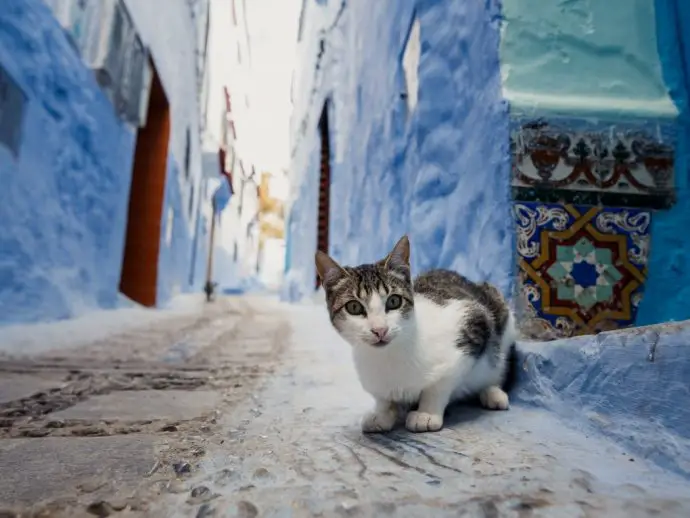
A slightly dishevelled figure lurched at us out of the darkness, his unkempt hair flying out at all angles and his clothes smelling sweetly suspicious. Tucked loosely under one arm was a woven jacket, once an array of incongruous colours but now caked in years of dirt and affection. We jumped aside, pressing ourselves up against the still warm blue wall, startling the resident cat and hoping to blend in with the shadows. We weren’t looking for a late night confrontation in this unknown Chefchaouen alleyway. Not tonight anyway.
“How are you? It’s a glorious night my friends!”
It wasn’t quite what we’d been expecting. A knife between the ribs perhaps, or at least a politely veiled enquiry into our current financial situation, but not this.
“Erm, hi, we’re good thanks, and it is indeed a lovely evening.”
How very British.
Slapping us good naturedly on the shoulders and grinning a little crazily, he flew off down the street, arms outstretched playing at aeroplanes, with accompanying noises not inconsistent with a 747. As an afterthought, he looked back over his shoulder and performed a pirouette, finishing with a slightly unstable flourish.
“Welcome to Chefchaoeun, people!”
Hubbie looked at me with raised brows, and we whispered the word at the same time. Kif! My beloved then did an alarmingly passable impression of Captain Jack Sparrow, whilst I executed a Rasta pose that I felt was right on the money. There was something in the air in Chefchaouen, and it was drawing us in.
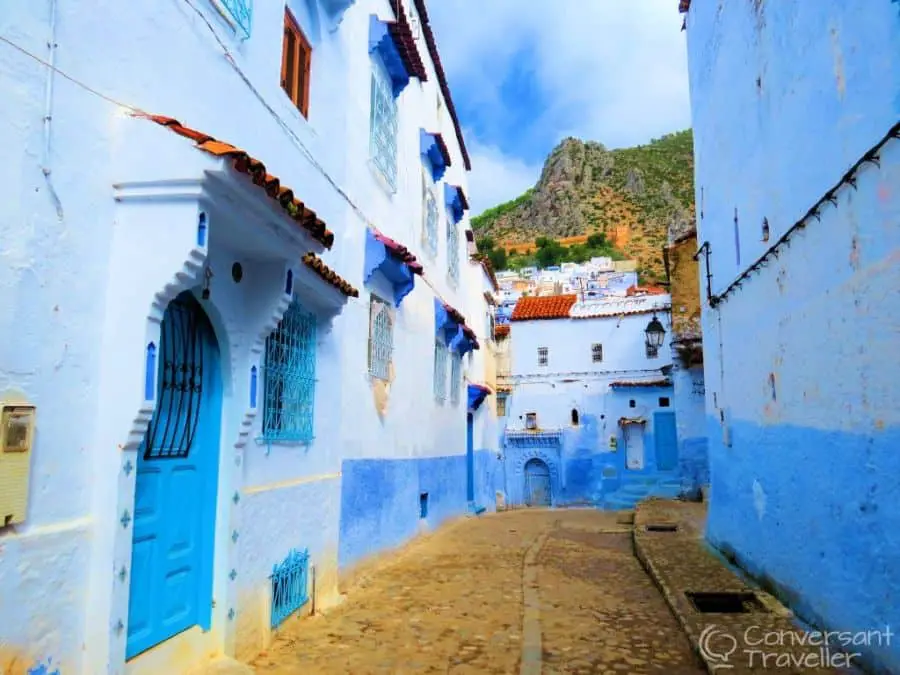
We had known that the striking blue-washed walls weren’t the only attraction in Chefchaouen, but hadn’t expected to be releasing the inner hippy quite so soon. This pretty mountain town nestled in the Moroccan Rif Mountains is also the kif capital of North Africa. That’s Cannabis to you and me.
People have been enjoying kif in the Rif for centuries
People often visit Chefchaouen because they are interested in buying drugs, and there are plenty of young men wandering the streets who can offer very good prices, yes sir. Much of their kif will be of dubious quality, if indeed they have any in the first place and aren’t instead police informers. Whilst a huge percentage of males in Morocco do smoke kif, it is still against the law. If it is your thing, and you can’t get your highs from the surrounding mountains or copious amounts of Berber ‘whiskey’ (mint tea) on offer, then it’s much safer to try to smoke with some local males, as then at least the quality of the stuff will be decent. Failing that, it is such an intrinsic part of Chaouen life that it is sold innocently at markets, right alongside the herbs and spices.
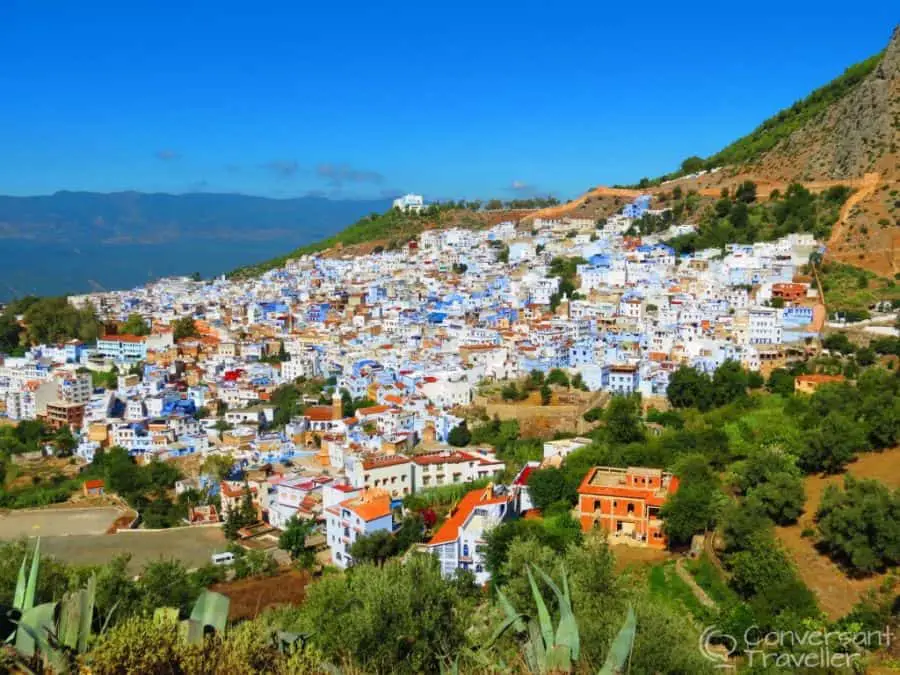
The region to the east of the town is given over to growing vast swathes of the stuff, which although technically illegal, has been overlooked by the government since it is in fact the ‘unofficial’ biggest foreign currency earner. As a result, for decades the pretty little town has been a haven for stoned backpackers as well as bohemian artist types. Falling into neither category, we decided to visit nonetheless and check out some of the best things to do in Chefchaouen.
Things to do in Chefchaoeun
Wondering what to do in Chefchaouen or how long to stay? We spent three nights here, and felt that was plenty. I had promised Hubbie that on this trip we wouldn’t rush around like lunatics, filling every minute of every day with ‘seeing and doing stuff’. Yet after a few days chilling in Chefchaouen it turns out I’ve been right all these years, and sitting around, no matter how glorious the view, just isn’t for us. It’s not that the city is dull, it’s just more about wandering the streets, taking photos and relaxing in cafes than hard-core sightseeing. Which isn’t necessarily a bad thing! So if you’re wondering if it’s worth visiting Chefchaouen then read on.
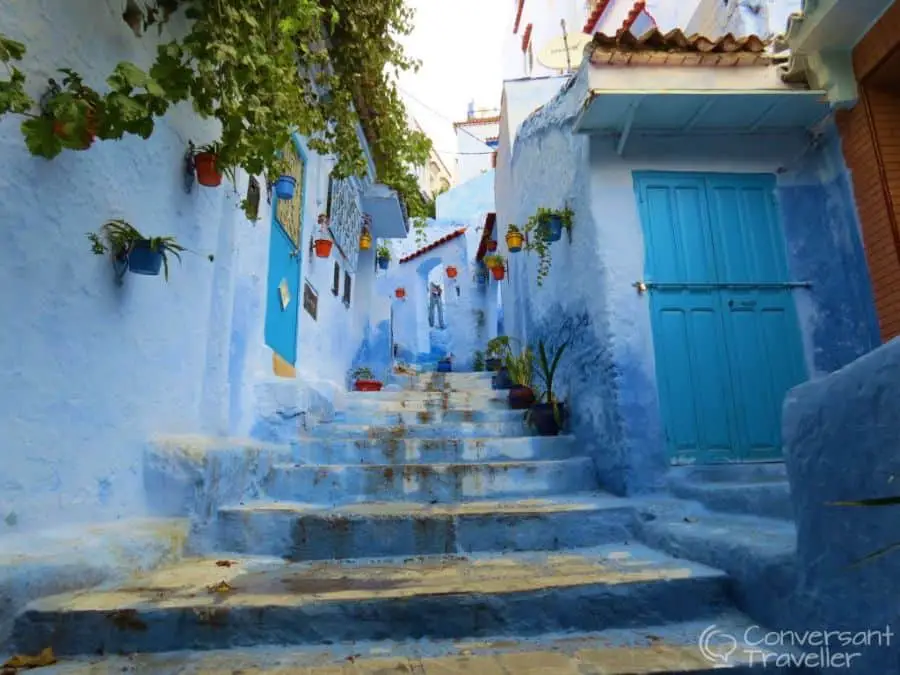
So, just what is there to see in Chefchaouen?
Where are the blue streets in Chefchaouen?
One of the most popular things to do in Chefchaouen is explore the blue streets, which you’ll find in the medina (old town)! Chefchaouen has one of the most accessible and easy to navigate medinas in all of Morocco. If you get lost, all you have to do is work out whether you are above or below the Plaza Uta el-Hamman (main square), and then walk either up or down hill to reach it, where you can ‘reset’ and start again. Most alleys seem to lead there anyway, whether or not you’re actually trying to reach it!
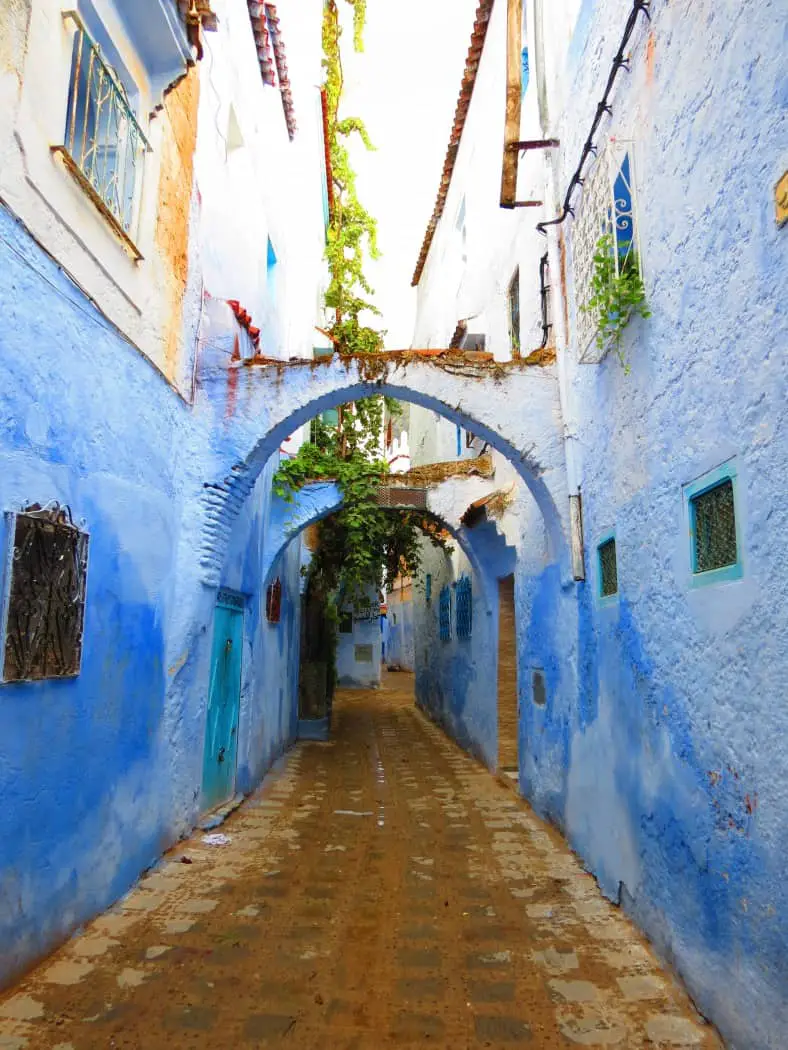
The first thing any visitor will want to do is of course wander the blue streets, a very pleasant way to spend a few hours, stopping on the way to admire the little shops that burst colour into the streets. If you’re wondering where to take photographs in Chefchaouen don’t worry, pretty much everywhere you turn is worthy of a shot! In fact the local tourist map of the town has some handy coloured routes which take you along the most photogenic blue streets. Although locals are used to tourists snapping away at their walls, the children are still refreshingly shy, and often will run away if they spy you with a camera, understandably not wanting their images to be taken. So do be sensitive, and always ask if you want to take a picture of a person (and if they agree, be prepared to offer a few dirhams as thanks).
The way of life here hasn’t changed much over the centuries, and rather than outsiders being able to purchase property to turn into riads, the population is very much made up of families who have passed down their houses through countless generations. Just as it should be.
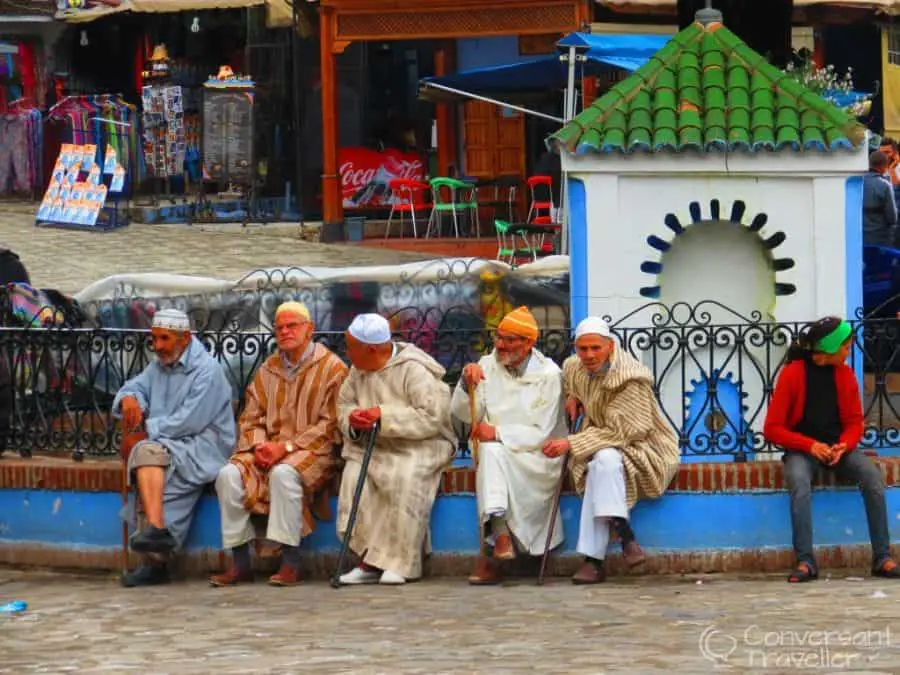
Locals are fairly relaxed (who wouldn’t be in such a beautiful place) and friendly, with far less hassle than you’d expect in places like Marrakech or even Fes. Shop keepers will attempt a half hearted sell, but are equally likely to want to chat to you about their neighbours goats, or the latest football scores.
Why is Chefchaouen blue?
Chefchaoeun is Andalucian in style, founded in 1471 by Moorish and Jewish refugees from Spain escaping persecution during the Catholic regime of Ferdinand and Isabela. Buildings were all white-washed, with the labyrinthine cobbled streets winding around the pedestrian medina, hiding secrets at every corner. Little has changed over the ensuing years, and you get the sense the exact same scenes were playing out several hundred years ago, with the very ancestors of the people before us today.
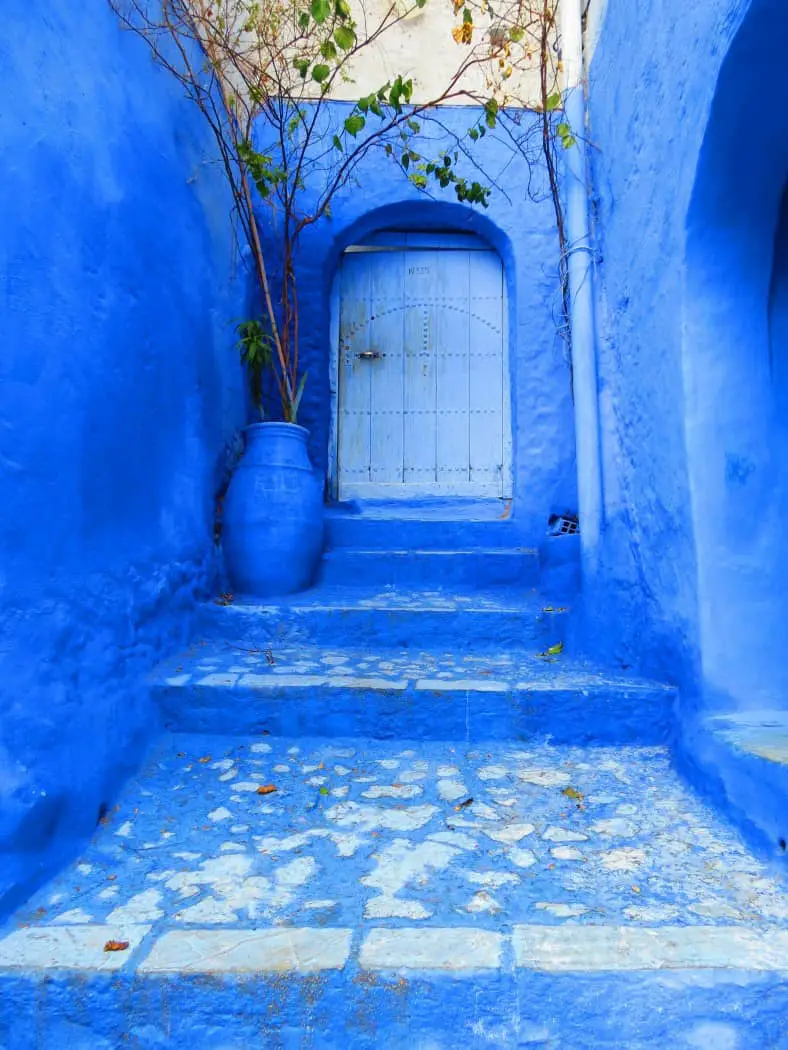
The blue of Chefchaouen is in fact a Jewish colour. When the last Jewish refugees arrived here in the 1930s fleeing the growing anti-semitic feeling in Europe, they painted their homes in the colour of the sky, representing heaven and much sought after peace. They certainly found it here, as have many visitors after them, and although much of the Jewish population has since moved on their colour and legacy remain.
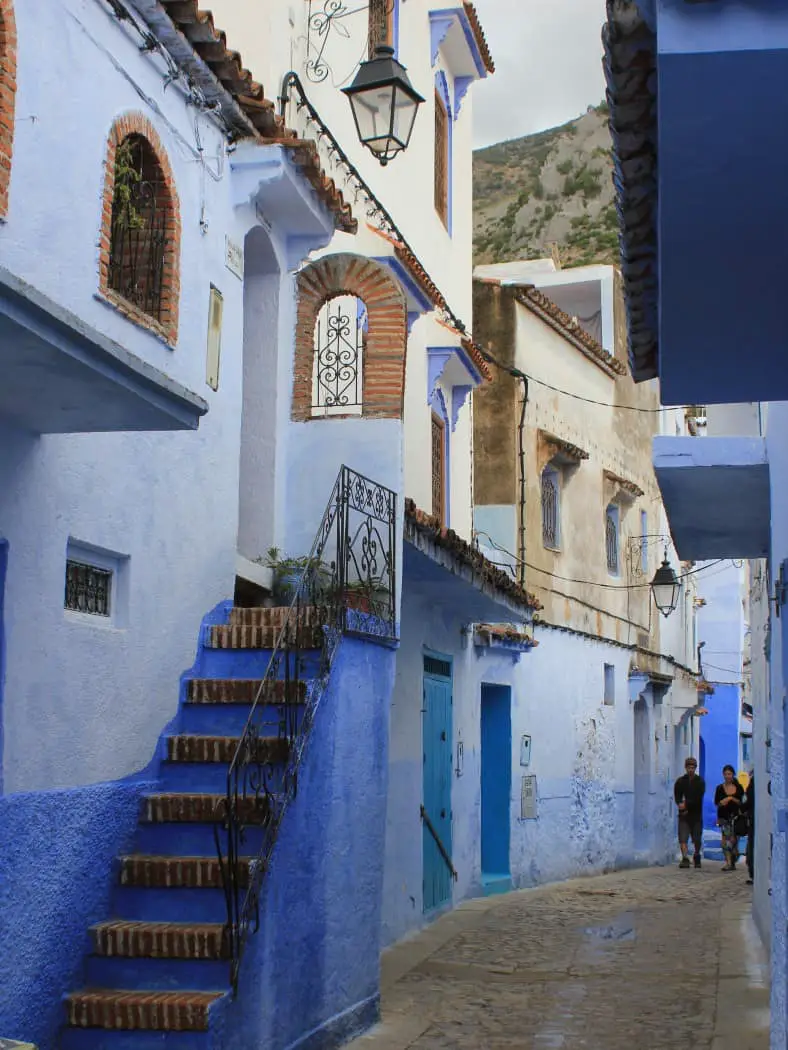
Interestingly green is the colour of Islam, and in many other towns and cities across Morocco you’ll find green roof tiles in abundance. Yet here, blue rules. You’ll see locals lovingly touching up their walls with azure paint, with both a sense of local pride and the recognition that it brings in the tourists. We did come across a solitary green door standing defiant amidst a sea of blue, but it was the only one.
Plaza Uta el-Hammam and the Kasbah
The main square of the medina is a great spot to get your bearings, as well as people watch. Pick one of the colourful cafes lining the square (any will do, they all serve the same food and drink at the same prices) and watch the world go by. If you time it so you’re there during one of the calls to prayer, you’ll see the locals trooping up to the Grand Mosque with its unique octagonal minaret. Of course non-Muslims are not allowed to enter. The square is also where locals gather to catch up with friends, and perhaps to watch the tourists go by.
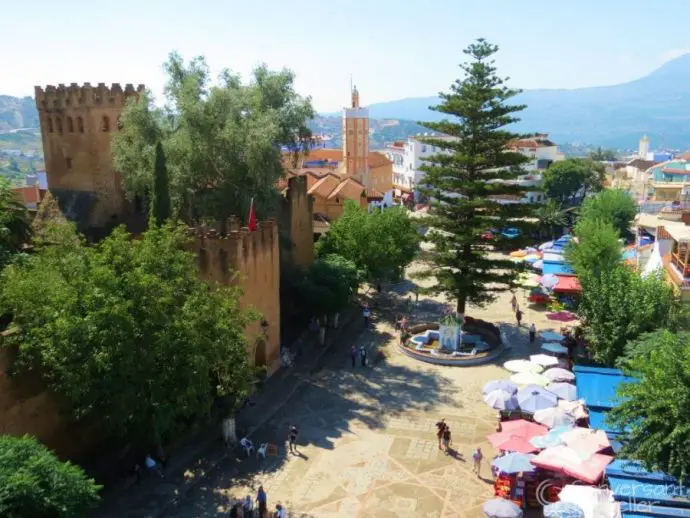
Next to the mosque, and also on the Plaza Uta el-Hammam, the heavily restored Kasbah is well worth a visit. Built by the legendary Sultan Moulay Ismail in the 18th Century it boasts great panoramic views from the tower, a lovely interior garden with fruit trees, an ethnographic museum, old prison and even a tiny art gallery.
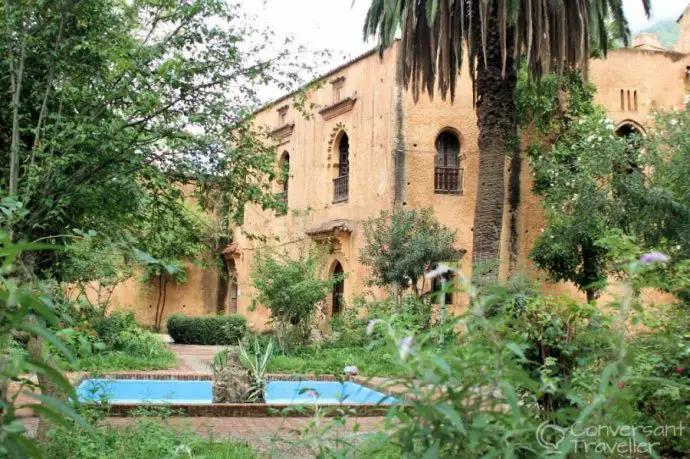
Give yourself an hour or two to explore, but just remember it closes over lunchtime. Entrance only costs DH10 per person, and includes all of the above. There isn’t much visitor information inside, and nothing in English, but if nothing else just go to soak up the ambience and take in the vistas, you won’t be disappointed. There are toilets as well, always a bonus.
Head for the hills
Once you’ve had your fill of blue streets, get out of the town and head into the hills. After all the town takes its name from the surrounding Rif Mountains – ‘chaouen’ meaning peaks, and ‘chef – chaouen’ literally translating as ‘look at the peaks’. So we did.
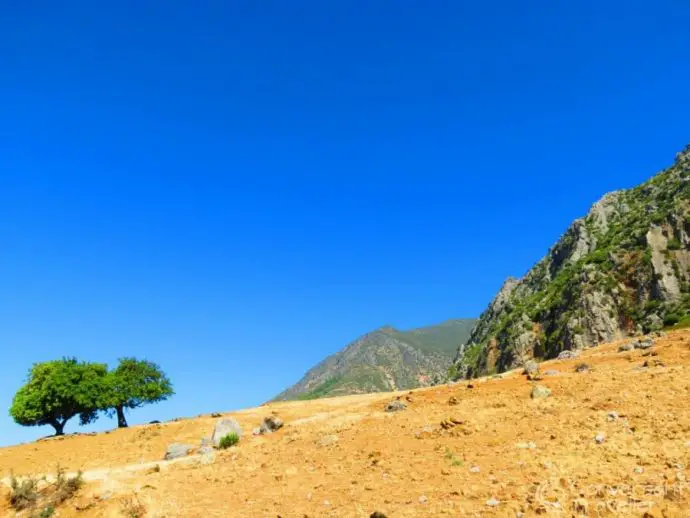
A pleasant morning walk begins at Bab al Ansar, the city gate to the east of the medina. After crossing the Ras el Ma river where local women go to do their washing, the dusty trail winds up past lines of prickly pear and agave cacti to an abandoned mosque overlooking the town. You’ll be sharing the path with locals going to and from their villages, as well as donkeys, sheep and even goats. If you fancy a longer hike you can continue past the mosque further into the Rif <ountains, eventually circling back down into the town, if you can distinguish your goat trails from your footpaths. Just don’t forget to take lots of water, there isn’t much shade.
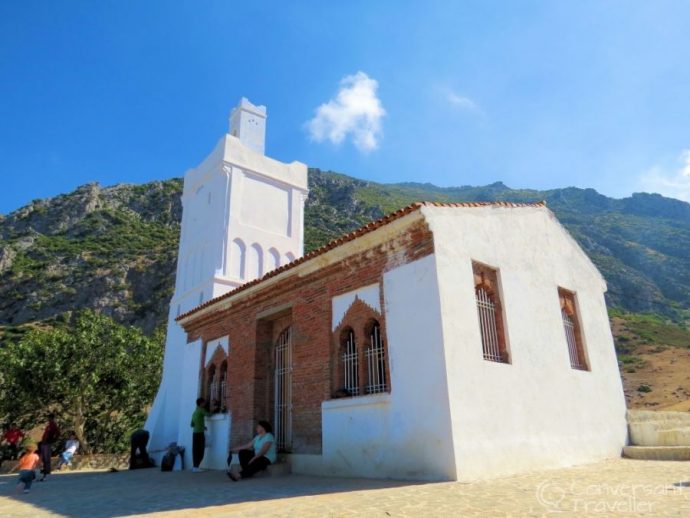
The Spanish-built mosque is one of the best Chefchaoeun viewpoints. It was abandoned in the 1920s during the Rif War, and today is a popular spot with local picnicing families and lads smoking kif in the Rif, as well as tourists.
I’m a little ashamed to relate this next part, but it’s all part of the parable, so onwards we go. During the walk Hubbie and I stopped to take a photo and a local chap passing by asked if we’d like one taking of the two of us. I eagerly agreed whilst Hubbie (who hates having his picture taken) stiffened slightly, no doubt worried we were about to play out the Mr Bean sketch where the chap runs off with the camera.
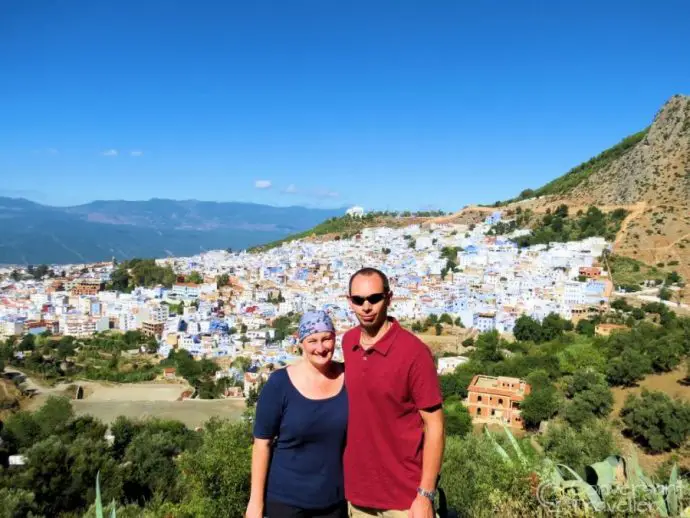
As the bloke began to back further and further away ‘for a better view’ I started to panic that Hubbie was right to feel uneasy, and started scouting around for rocks to use as missiles should the aforementioned come to pass. Hubbie later reminds me I throw like a girl so that would have been a bit pointless anyway.
In the event the guy took the photo, handed back the camera and with a few cheery words went merrily on his way. We immediately felt contrite that we’d been suspicious, and subsequently gave an extra big smile to all the locals we passed after that. They no doubt thought we’d been sampling the kif.
Still, he did manage to chop our feet off (why ,why, why do people do that?) and clearly hasn’t learnt the rule of thirds when framing a shot, so perhaps we can give ourselves a bit of slack after all!
Where to Stay in Chefchaouen
The main decision to make when it comes to finding the best place to stay in Chefchaouen is whether you want to be in the heart of the medina, or up on the hillside overlooking the town. We researched long and hard and came up with these hotels and riads in Chefchaouen:
Chefchaoeun medina riads
Dar Baibou – a truly beautiful and colourful riad with hammam and air conditioning
Dar Zambra – a traditionally decorated riad with a gorgeous roof terrace and panoramic views
Hotel Casa Miguel – a small riad with blue painted walls and mountain views
Riad Cherifa – it’s very unusual to find a medina riad with a pool!
Chefchaouen hillside hotels
Dar Echaouen – traditionally decorated bungalows dotted over the hillside with a fabulous pools and terrific views
Lina Ryad and Spa – a spa hotel with great views from the rooftop terrace
Dar Jasmine – a smart, comfortable option with a beautiful terrace
Riad Nila – a cute and classy riad with those all-important terrace views
We ended up staying at Dar Echoaouen because we really wanted some views. Normally we’d have gone for a cosy little riad in the old town, but were overall were really glad we’d opted for a hillside hotel which came with cooling mountain breezes rather than the stifling heat of the medina where the air hardly moves.
Here’s what we thought of Dar Echaouen:
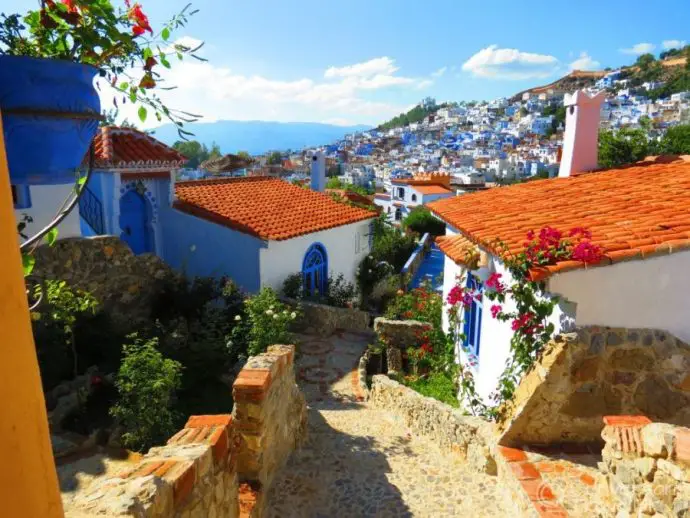
Dar Echchaoeun up on the hillside was a risky choice since I knew it catered for tour groups, but having read lots of good reviews and liking the idea of a pool, we plunged straight in. Their website was miles ahead of the others, which was also a deciding factor (I’m a sucker for good websites).
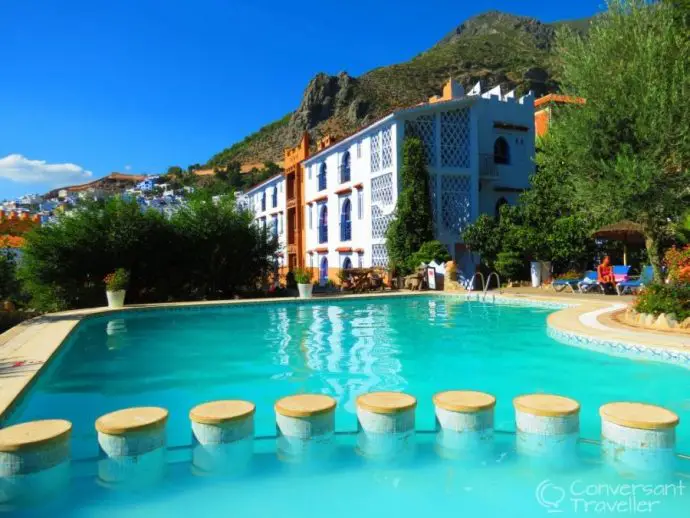
The views were as stunning as promised, the pool a great way to spend a hot afternoon after sweating in the streets of the medina, and our suite (no. seven) was fabulous. We had booked a room but I reckon a tour group must have wanted all the standard rooms, and since we’d booked early we’d been moved out into a suite instead, at no extra cost! This happens to us a lot, booking early definitely has its rewards!
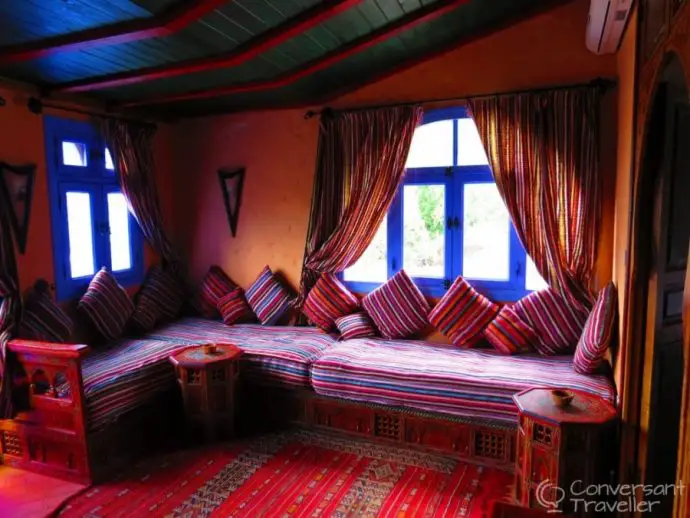
The suite of course had to be the furthest one away from the main building, but with that came more privacy than the other rooms, and some fabulous views from the little balcony just off the salon. Great for watching the sunset over the town and surrounding peaks.
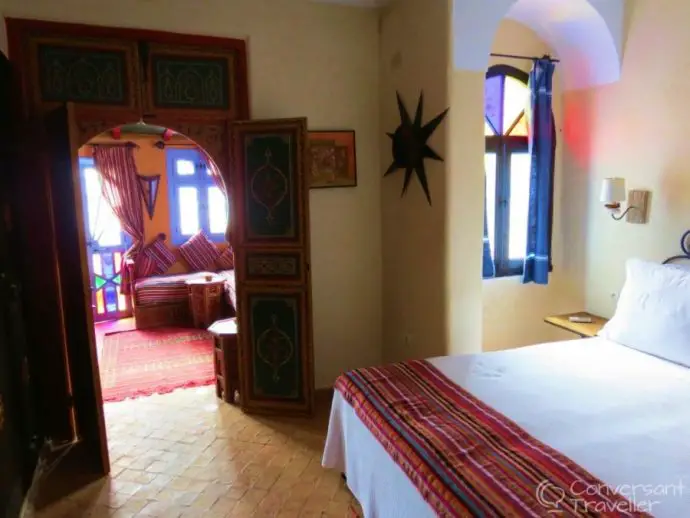
Yet the service was average at best (tour groups definitely got preferential treatment), the food was some of the worst we’ve ever had in Morocco, and the nearby dogs and cockerels made so much noise we hardly slept.
It was definitely cooler up on the hillside than down in the medina, and I can imagine some of the properties down there will be quite stuffy at night without the airflow. Having said that, if we ever visit again, the medina it is!
Where to Eat in Chefchaoeun
Now I’ve always relished our visits to Morocco, one of the reasons being the most excellent cuisine on offer. The food has always been of the highest standard, and it’s something we’ve come to expect as the norm. Chefchaoeun seems to be the exception. After our dreadful meal at Dar Echchaouen on the first night (think wallpaper paste for soup and you’re getting there), we opted to eat in the medina for the next two nights, thinking surely we were in for a treat.
The first evening we patronised the gloriously over-decorated La Lampe Magique restaurant, after scouting it out earlier in the day for an impromptu drink and nibbles. It has the best situation overlooking the Plaza Uta el-Hammam and it’s mulberry trees, as well as the kasbah.
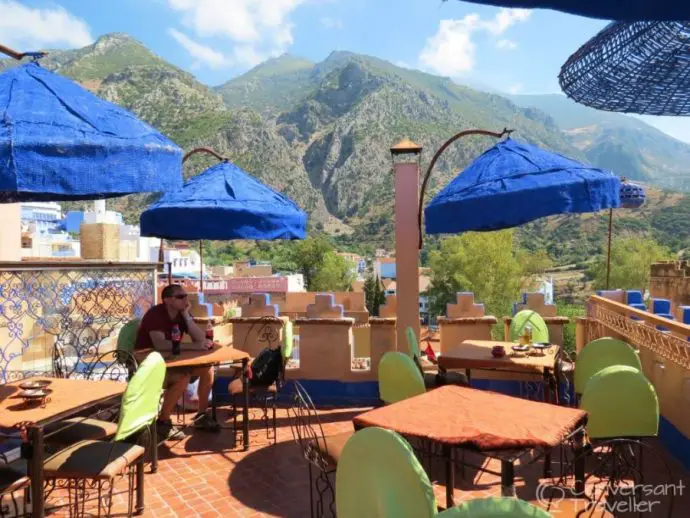
There are several levels with different seating areas, including a couple of roof terraces which are great for the 360 degree panoramic views. The inside restaurant comprises little alcoves, 1001 nights style interiors, with lots of cushions, candles and suitable chill-out music. Perfect for a little romance.
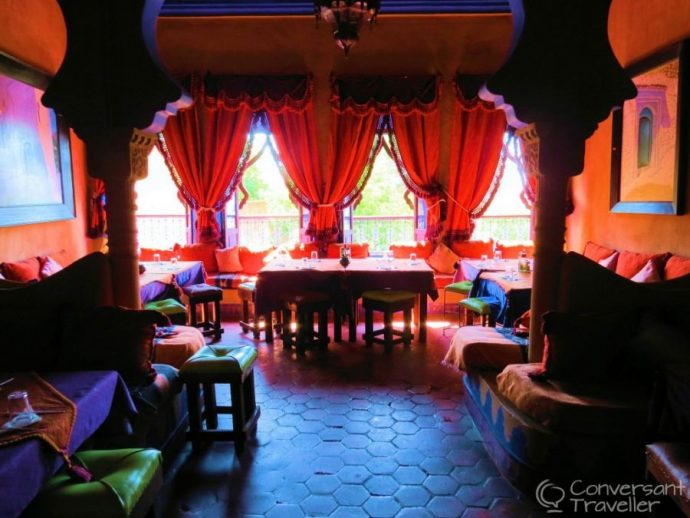
The standard 3 course tourist menu here was DH85, a bit more expensive than a lot of other places, which seemed to average at DH60. You don’t of course have to go the whole hog, but as Hubbie never passes up an opportunity for food, we got stuck in. The food was decent, flavoursome, if a little dull considering the surroundings. The tagine was tiny compared to pretty much everywhere we’d been, and Hubbie’s was only luke warm, but it ‘did the job’, to coin a favourite phrase of my father. Chocolate pancakes for dessert were a welcome change from the usual cinnamon dusted oranges and creme caramel.
Worth a visit if only for the stunning view of the medina.
We also tried Al Kasbah restaurant, on an alley right next to the square. Another enticing space with little private booths, Moroccan tent style drapes and an endearing yet motley assortment of wrought iron furniture. After fending off unrequited offers to watch football in the main restaurant (honestly, why does everyone assume all British tourists love the game?), we managed to get an outside booth all to ourselves. Great for privacy, not so great for service. Still, the food was palatable, if nothing special, and the pastilla was surprisingly tasty and not dry like many we’ve come across. So they get a thumbs up for that, at least. The 3 course menu here was DH60, and better value than La Lampe Magique, though without the views.
Language in Chefchaoeun
It was really frustrating knowing which language to use here. Spanish is spoken more widely than French, so I was relishing being able to hold proper conversations with the locals and indeed in some restaurants this was the case, to my delight and possibly theirs. However the rest of the time I’d launch into Spanish, and they would reply in French, English or sometimes Arabic, leaving me wondering just what are the rules?

By the end of the three days I was constructing sentences using bits and pieces from all four languages, and no-one seemed to blink an eye, it was the normal way to communicate and I began to quite like it. When it doubt, insert vocab from another language and away you go. Brilliant!
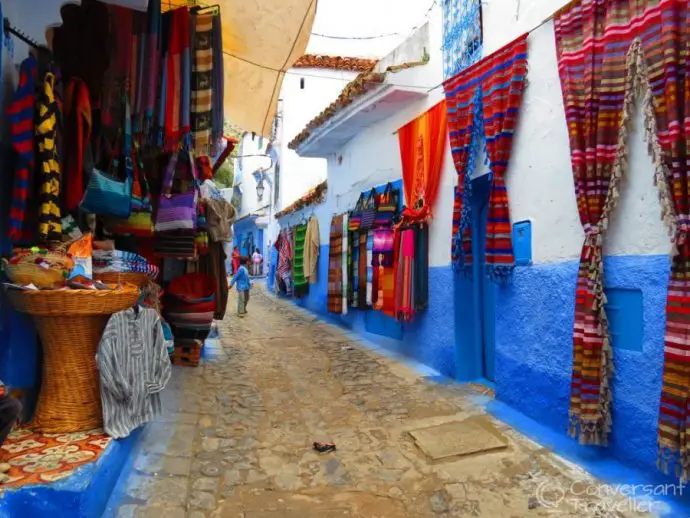
As we made our way back to the guest house through the darkened alleyway one last time, the sound of rather ecstatic singing caught our ears. As it came closer we grinned to each other and launched into over the top greetings and exaggerated pleasantries as the aspirant chanteur appeared around the corner. Perhaps the Chefchaouen euphoria was catching after all. This time he seemed to have lost his lovely jacket, and dreadlocks now had his hair looking much tidier, but his sentiment remained the same.
“Helloooooooooooo people, how are you doing, welcome to Chefchaouen, land of the….”
We never found out what land it was, but it didn’t take much to make a guess.

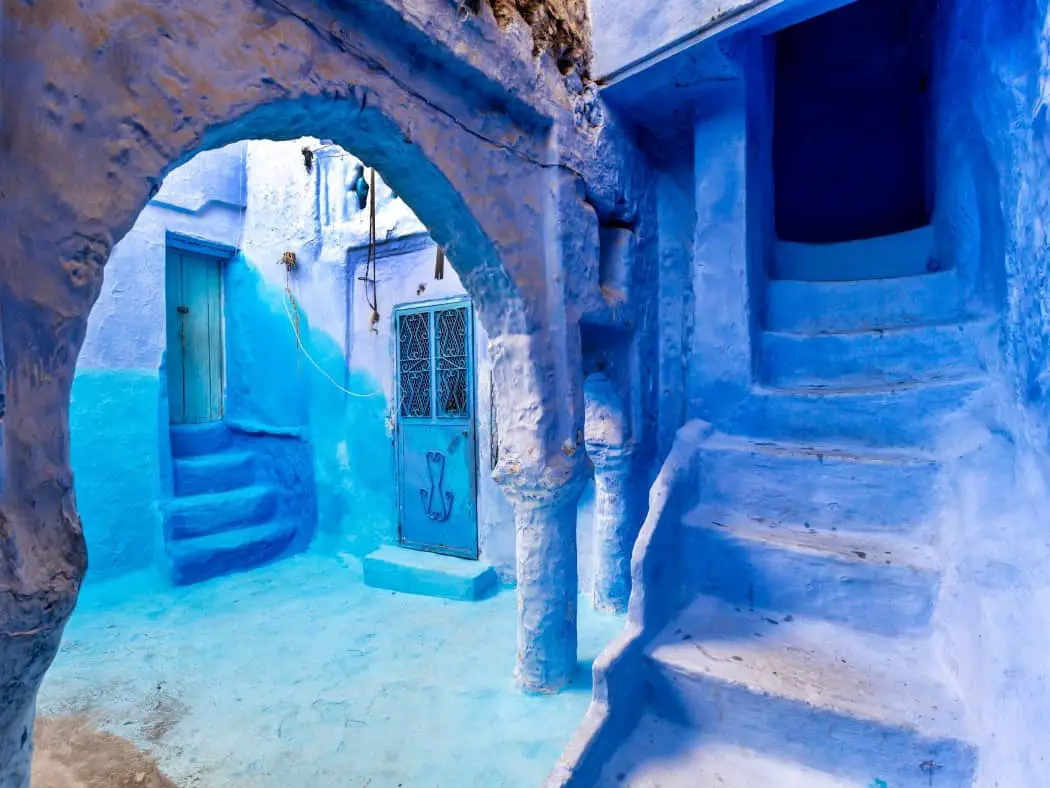
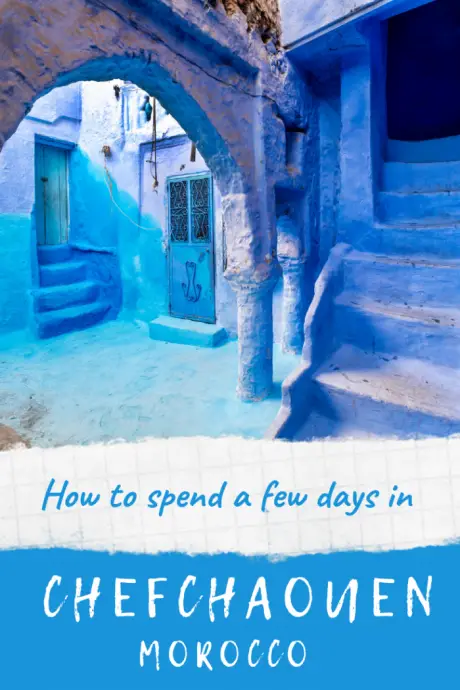
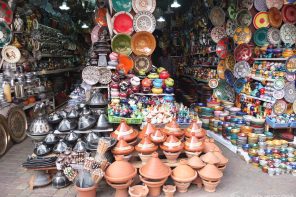
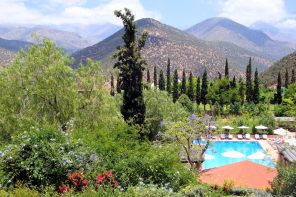
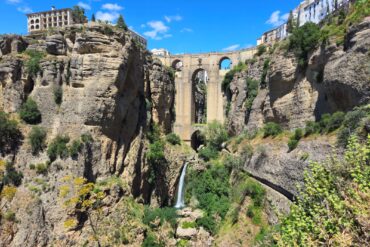
Really gorgeous. The blue of the buildings in Chefchaoeun reminds me of Jodhpur in India; only the meaning behind the color is a little different there than here in Morocco. I had never heard of this mountain area but Wow, am glad I have heard of it now.
I love the different symbolisms of colour around the world, would love to visit Jodhpur too!